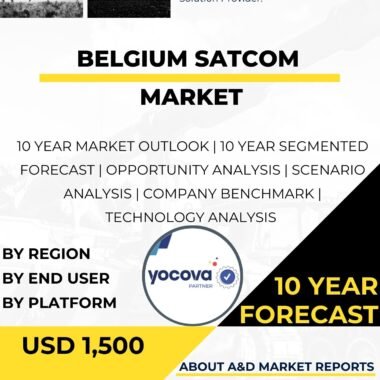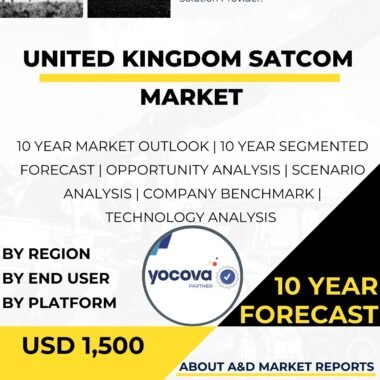Description
The satellite communications (SATCOM) market in Japan has experienced significant growth and strategic importance as the nation focuses on enhancing its communication capabilities, expanding its space-based infrastructure, and strengthening its national security and disaster response capabilities. SATCOM systems utilize satellite technology to enable secure and reliable communication across various sectors, including defense, government, commercial, and emergency response. As Japan seeks to enhance its global connectivity and ensure robust communication networks, the demand for advanced SATCOM solutions has grown, leading to increased research, development, and investment in this field.
The SATCOM market in Japan encompasses a wide range of satellite communication systems and services, including geostationary satellites, low Earth orbit (LEO) satellites, Very Small Aperture Terminals (VSATs), and mobile satellite services (MSS). These SATCOM solutions play a vital role in providing seamless connectivity and data transmission over long distances, remote areas, and challenging terrains.
One of the primary applications of SATCOM in Japan is in defense and national security. SATCOM systems are integral to Japan’s defense infrastructure, enabling secure and real-time communication among military forces, command centers, and remote outposts. These systems support various military operations, including intelligence gathering, reconnaissance, surveillance, and battlefield communication.
Moreover, SATCOM plays a crucial role in Japan’s disaster response and emergency communication capabilities. During natural disasters, such as earthquakes, tsunamis, and typhoons, terrestrial communication infrastructure may become damaged or overloaded. SATCOM provides a reliable backup for emergency communication and coordination among response teams, facilitating efficient disaster relief operations.
Additionally, SATCOM contributes to Japan’s maritime surveillance and maritime domain awareness. SATCOM-equipped maritime vessels, aircraft, and unmanned aerial vehicles (UAVs) support Japan’s Maritime Self-Defense Force (MSDF) in monitoring maritime activities, detecting illegal fishing, and ensuring maritime security.
As Japan emphasizes indigenous space capabilities, the domestic production and development of SATCOM systems have seen substantial growth. Collaborations between the government, private industry, and research institutions have fostered innovation, leading to the creation of advanced SATCOM solutions tailored to Japan’s specific communication requirements.
Japan’s alliance with the United States has also played a significant role in the development of its SATCOM capabilities. Through this partnership, Japan has access to advanced satellite technologies, space assets, and expertise, contributing to the modernization of its defense and communication infrastructure and enhancing interoperability with allied nations.
The SATCOM market in Japan also benefits from advancements in satellite technology, data transmission, and ground segment infrastructure. Manufacturers have leveraged these developments to create SATCOM solutions with higher data rates, increased bandwidth, and improved signal reliability.
However, the SATCOM market in Japan also faces challenges related to cybersecurity, spectrum management, and space debris. Ensuring the security and resilience of SATCOM networks and data transmission is crucial, as potential adversaries may attempt cyber-attacks to disrupt communication systems.
Efficient spectrum management is essential for optimizing SATCOM operations and avoiding interference between satellite systems and other communication services. Coordinating satellite orbits and frequencies is critical for ensuring uninterrupted communication services.
Moreover, addressing the growing issue of space debris is vital for maintaining the sustainability of space-based infrastructure. Collaborating with international partners and adhering to space debris mitigation guidelines can help mitigate the impact of space debris on satellite systems.
In conclusion, the satellite communications market in Japan has witnessed significant growth and strategic importance, driven by the nation’s focus on enhancing its communication capabilities, expanding its space-based infrastructure, and strengthening its national security and disaster response capabilities. SATCOM solutions provide critical capabilities for defense, disaster response, maritime surveillance, and global connectivity, making them integral to Japan’s communication and security strategy. The collaboration between the government, private industry, and research institutions, as well as international partnerships with allied nations, fosters innovation and contributes to the growth of the domestic SATCOM market. Addressing challenges related to cybersecurity, spectrum management, and space debris is crucial for further enhancing Japan’s SATCOM capabilities and ensuring that the nation remains equipped with advanced and resilient SATCOM systems to effectively respond to evolving communication needs and maintain regional and global connectivity. With its strategic focus on enhancing indigenous space capabilities, Japan remains committed to leveraging advanced SATCOM technologies to enhance its communication infrastructure and contribute to regional and global connectivity and security.




